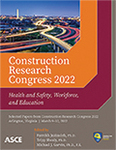Investigation of Factors Impacting Situation Awareness of Highway Workers and Applicable Warning Methods
Publication: Construction Research Congress 2022
ABSTRACT
Dynamic worksite conditions and proximity to live traffic frequently expose highway workers to unsafe proximities, resulting in accidents. Improving workers’ situation awareness is one of the measures to prevent worksite injuries. The research investigates factors that impact workers’ situation awareness in highway work zones and explores applicable human-centered hazard warning methods under various worksite scenarios. To this end, two surveys were conducted with construction workers and managers. The first survey aims to compare the participants’ perception of worksite injuries, safety management, and the company’s safety culture. It also investigates the difference of perception between workers and managers that contributes to unsafe behaviors. The second survey investigated workers’ hazard detection ability under various work zone conditions, warning alarm methods preference, and wearable warning device location preference. The research looks into situation awareness from multiple aspects and provides helpful advice for human-centered alarm design based on highway workers’ experiences. The results provide a useful reference for wearable PPE design to improve roadway worksites’ safety levels.
Get full access to this article
View all available purchase options and get full access to this chapter.
REFERENCES
Awolusi, I., C. Nnaji, E. Marks, and M. Hallowell. (2019). “Enhancing construction safety monitoring through the application of internet of things and wearable sensing devices: A review.” Computing in civil engineering 2019: Data, sensing, and analytics: 530–538.
Carbonari, A., A. Giretti, and B. Naticchia. (2011). “A proactive system for real-time safety management in construction sites.” Automation in construction 20(6): 686–698.
Endsley, M. R. (1995). “Toward a theory of situation awareness in dynamic systems.” Human factors 37(1): 32–64.
Endsley, M. R., and D. J. Garland. (2000). Situation awareness analysis and measurement, CRC Press.
Han, W., E. White, M. Mollenhauer, and N. Roofigari-Esfahan. (2019). A Connected Work Zone Hazard Detection System for Roadway Construction Workers. Computing in Civil Engineering 2019: Smart Cities, Sustainability, and Resilience, American Society of Civil Engineers Reston, VA: 242–250.
Hasanzadeh, S., B. Esmaeili, and M. D. Dodd. (2017). “Measuring the impacts of safety knowledge on construction workers’ attentional allocation and hazard detection using remote eye-tracking technology.” Journal of management in engineering 33(5): 04017024.
Hines, K., W. Lages, N. Somasundaram, and T. Martin. (2015). Protecting workers with smart e-vest. Adjunct Proceedings of the 2015 ACM International Joint Conference on Pervasive and Ubiquitous Computing and Proceedings of the 2015 ACM International Symposium on Wearable Computers.
Kamal, I. S. M., I. N. Ahmad, and M. I. N. Ma’arof. (2013). Review on accidents related to human factors at construction site. Advanced Engineering Forum, Trans Tech Publ.
Kim, K., H. Kim, and H. Kim. (2017). “Image-based construction hazard avoidance system using augmented reality in wearable device.” Automation in construction 83: 390–403.
Li, H., M. Lu, S.-C. Hsu, M. Gray, and T. Huang. (2015). “Proactive behavior-based safety management for construction safety improvement.” Safety science 75: 107–117.
Lim, S., S. Chi, J. D. Lee, H.-J. Lee, and H. Choi. (2017). “Analyzing psychological conditions of field-workers in the construction industry.” International journal of occupational and environmental health 23(4): 261–281.
Shappell, S. A., and D. A. Wiegmann. (2000). “The human factors analysis and classification system--HFACS.”
Teizer, J. (2015). “Wearable, wireless identification sensing platform: self-monitoring alert and reporting technology for hazard avoidance and training (SmartHat).” Journal of Information Technology in Construction (ITcon) 20(19): 295–312.
Teizer, J., B. S. Allread, C. E. Fullerton, and J. Hinze. (2010). “Autonomous pro-active real-time construction worker and equipment operator proximity safety alert system.” Automation in construction 19(5): 630–640.
Van der Molen, H., and P. Hoonakker. (2000). Work stress in the construction industry: causes and measures. Proceedings of the Human Factors and Ergonomics Society Annual Meeting, SAGE Publications Sage CA: Los Angeles, CA.
Wickens, C. D. (2008). “Situation awareness: Review of Mica Endsley’s 1995 articles on situation awareness theory and measurement.” Human factors 50(3): 397–403.
Zhou, C., and L. Ding. (2017). “Safety barrier warning system for underground construction sites using Internet-of-Things technologies.” Automation in Construction 83: 372–389.
Information & Authors
Information
Published In
History
Published online: Mar 7, 2022
Authors
Metrics & Citations
Metrics
Citations
Download citation
If you have the appropriate software installed, you can download article citation data to the citation manager of your choice. Simply select your manager software from the list below and click Download.
